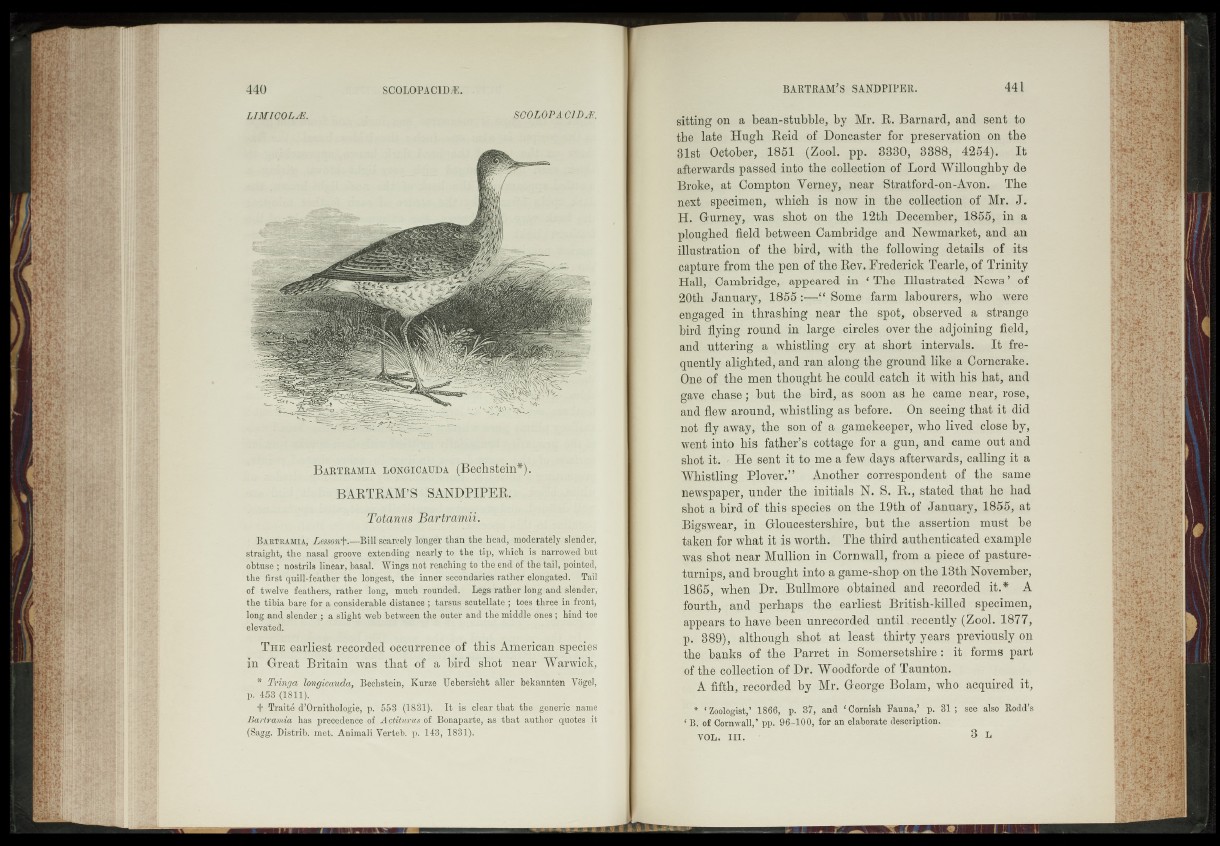
LIMIGOLÆ. mQLOPAClDÆ.
_Baetramia> L^oiCAUjfA^ (Bechst'e^jf^'
BARTRAM# SANDPIPER^
* ; Vofânus Bartramùy ^
■ Bartramia, / ^ 0Jif^ïS'feç aç:§ly 1-onger $Æn the h ead, ffipdfflj^yqff&der,
ÉîtraigMj the nasal .groove ,eÿep.dingr nearly" to, the 1 i g) s‘narrowed, but
obtuse ; nostrils linear, basal. Wings not reaching to thei en'd ÿ theism, pointed,
the^nrst^uiir-feather ÎBe w îfe lt, rae^innfef second^rieê^rather dongâïfd..* 5Tâi 1
of twelve feathers, rather long, much rounded. Legs rather ÿcmg>and.slënder,
the tibia bare for .a considerable distance ;j tarsus sc»te^ate_>; toes three i/ufremt,
long and slender ; a slight wgb betwee/i ffifejCffter and the middle «mes ;/mhd toe
elevated.
T h e e a r n e s t , recorded* o e c u tre n ‘( ^ ^ * t h i s A m e r ic a n sp e c ie 4,
i n * G r e a t B r ï t a m v ^ ^ t ï i â î ‘ o f a b b m f sh o t1 “n e a r W a n u o k ,
% ffiijrigci, bngicoMjia^ Bechstein, Kurze UebersiGht, aller bekannten ^ogel,
"p. i b ^ § n )%
Traité d>Omithologie, p.?‘553V(4f$ S '* It 'i&Jclear that the gtncriOname
Bartra,mi&\h&& pre<$,dence,«Qf JA ofj.Bonappt.e, as <t]g|S& author quotas Jit
(Sagg. Dîstecb, met. Anjjnali. Verteb.™j>P 143,,^831^
sitting on a bean-stubble, by Mr. R. Barnard, and sent to
the late Hugh Reid of Doncaster for preservation on the
81st October, ,4.851 (Zool. pp. 8380, 3388, 4254)* It
afterward^ passed into the collection of Lord Willoughby do
Broke, at Compton Yerney, near Stratford-on-Ayop. The
next specimen, which is now in the collection of Mr. J.
H., gurney, was shot on tbp 12th. December, 185$, in a
ploughed field between Cambridge and Newmarket,; and an
pf -.the J>k&, with tbe, following details of its
capture from the pen of the I^ev. Erederiek Tearle, of Trinity
Hall,'Cambridge,,-appeared in ‘ Illustrated [News’ of
gO,tb January, 1855:—“ Some farm labourers, who were
engaged in. thrashing near the spot, observed a strange
bird tying round in large circles pyer the adjoining field,
and itteying a whistling , cry at -short, intervals. It-frequently
alighted, and ran; along the ground like a Corncrake.
Qpe of the men thought he copld catch it with his hat, and
gave, chase; but;,the bird, as, sopn as he came; near, rose,
and flew around, whistling as; before, m On seeing that it did
ftot fly away, the son of ,a- garnekpeppr, whA lived ! elope by,
went into his father’s, parage for a gqp, and came p,pt and
shot ih - He sept it to me a few days afterwards, calling it a
Whistling Plover.” -^pother,' correspondent of the same
newspaper) -under the,; initials N. S. , R., stated that he had
shot,a bird of this sp^cies,nnt,%e 19th of Janu^ry,>il855, at
Bagswear, ip ^Clopcestei^hire, hut the .-assertion must,he
taken for what^t is worth* The third authenticated example
wa,s shot-near Mulhon inf Cornwall, from a-piece of pastpre-
tprnips, and brought intoa; game-shop qp the 13th November,
1B05, when Dr. Bulbnojfe - obtained-|and recorded at-* A
fourth, apd .perhaps the 'earliest British-lplled; specimen,
appears to have been unrecorded until.recently (Zool. ,1877,
p, 389), althppgh shpt at least thjfty^years .'previously on
the banks of the Parrot in Somersetshire: it-, forms part
of the oplleptioppf D-r. W.C'odforde of Taunton.
, - A fifth, recorded by Mr, George Bolam, whoJ acquired it,
* pr 3?, and ‘ Cornish Fauna,’ p. S t ; see also Rodd'g
',^-B;, of Cornwall,’ pp^9&SM^fe>r an elaborate description.
vol. i n . • . . . X*., ■ - .«.J I^ l I